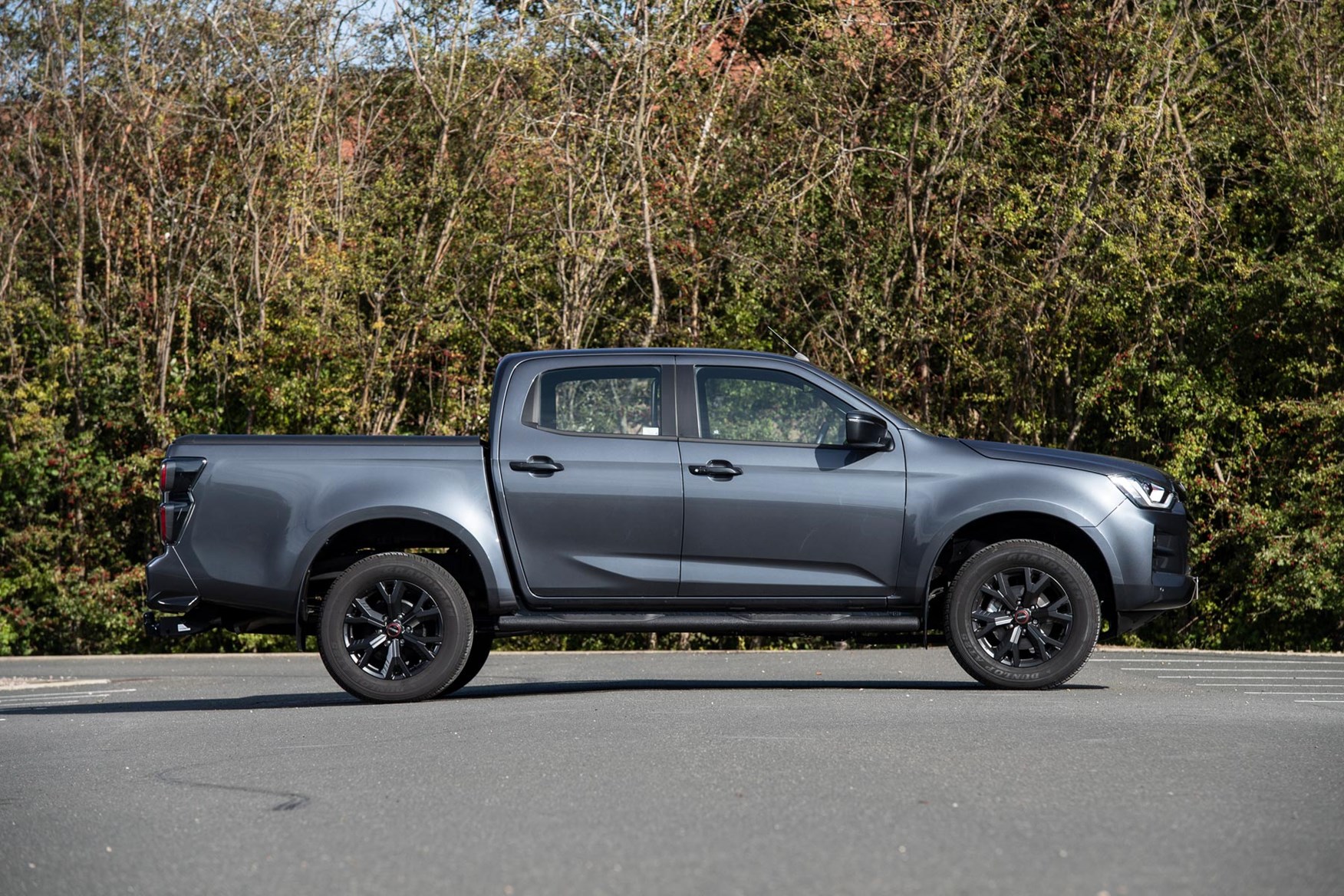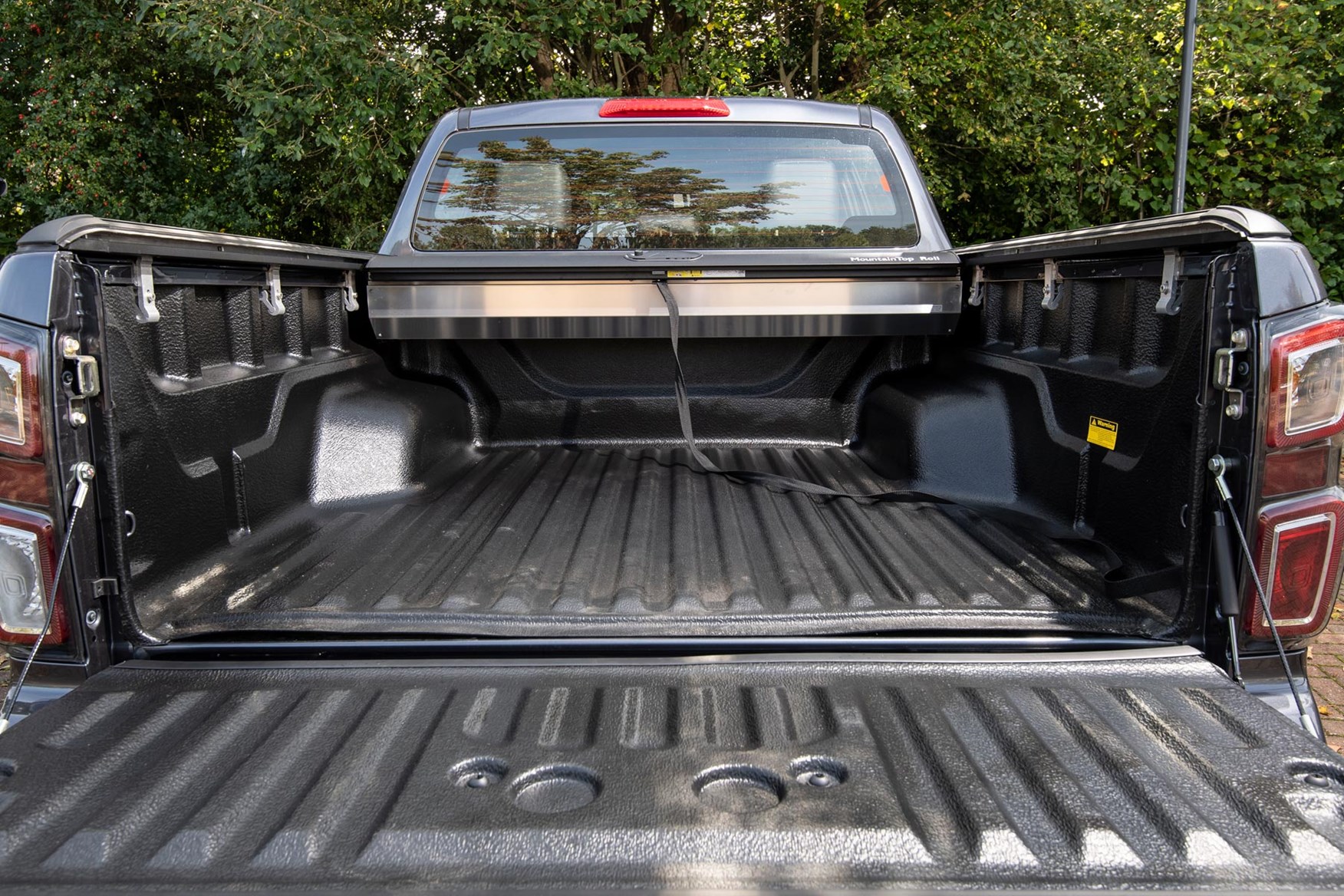Isuzu D-Max dimensions (2021-on)
Looking for dimensions info for the 2021-onwards Isuzu D-Max pickup truck? Then you’ve come to the right place – we’ve got all the exterior sizes plus the load bed dimensions for all three body types right here.
You will also find payload and towing capacity information on this page.
However, for details of what the second-generation D-Max is like to drive, its standard equipment, running costs, mpg and value, see our main 2021 Isuzu D-Max review page.
The second-generation Isuzu D-Max pickup comes in three body types: Single Cab, Extended Cab and Double Cab. The exterior dimensions are only subtly different, but the load space varies considerably.
Single Cab models have two doors and two seats, and are intended to be pure working vehicles. As such, they only come in the entry-level D-Max Utility trim. They are slightly longer and slightly narrower than other versions, and have the largest load area.

Extended Cab models come with a set of secondary rear doors and occasional-use rear seats; the rear doors open backwards, and can only be accessed when the front doors are also open. There is no traditional b-pillar, so the opening is large, but the rear seats offer limited leg room and general comfort.
The load area size falls between the Single and Double Cab models, and you have a choice of two D-Max trim levels, Utility and DL20.
Double Cab models are available in every trim level, and have four proper doors and four proper seats. They have the greatest amount of passenger room and are best suited for dual-purpose working and lifestyle use, but also have the smallest load bed.

All models have step built into the rear bumper to aid access to the load space, and every Double Cab model comes with a tailgate damper, which means the tailgate folds down gently rather than droping with a hinge-straining clang.
Isuzu D-Max exterior dimensions
This table compares the exterior dimensions of all three Isuzu D-Max body types:
| Isuzu D-Max | Single Cab | Extended Cab | Double Cab |
| Exterior length | 5,305mm | 5,265mm | 5,265mm |
| Exterior height | 1,770mm | 1,790mm | 1,790mm |
| Exterior width | 1,810mm | 1,870mm | 1,870mm |
| Wheelbase | 3,125mm | ||
| Front overhang | 890mm | ||
| Rear overhang | 1,290mm | 1,250mm | 1,250mm |
| Ground clearance Utility | 225mm | ||
| Ground clearance others | n/a | 235mm | 235mm |
| Approach angle | 29 deg | 31 deg | 31 deg |
| Departure angle | 23 deg | 24 deg | 24 deg |
| Breakover angle | 22 deg | ||
Isuzu D-Max load bed dimensions
This table compares the cargo space dimensions of all three Isuzu D-Max body types:
| Isuzu D-Max | Single Cab | Extended Cab | Double Cab |
| Load bed length | 2,315mm | 1,805mm | 1,495mm |
| Load bed width | 1,530mm | ||
| Load bed depth | 490mm | ||
That load bed depth is 30mm deeper than the previous D-Max, and every version now has a larger load space.
While the latest D-Max is much plusher than its predecessor, it retains great working capability and the payload and towing capacities that go with this.
Isuzu D-Max payload ratings
All versions of this D-Max have a 3,100kg gross vehicle weight (GVW) – bar the entry-wheel Utility two-wheel drive (4x2) Single Cab, which is reduced to 3,000kg. GVW is the total legally allowed weight of the pickup and everything on board – including the people.

That’s not a massively high number, but even the very heaviest version of the D-Max barely exceeds 2,000kg kerbweight (the basic weight of the vehicle itself), which means they all have payload capacity that comfortably exceeds 1,040kg – making it legal to fit a hardtop over the load area and still retain full commercial vehicle status for tax purposes.
Here are the full payload ratings for the second-gen D-Max range (at time of writing in April 2021):
| Isuzu D-Max | Kerbweight | Payload | GVW |
| Utility Single Cab 4x2 | 1,795kg | 1,205kg | 3,000kg |
| Utility Single Cab 4x4 | 1,895kg | 1,205kg | 3,100kg |
| Utility Extended Cab | 1,960kg | 1,140kg | 3,100kg |
| Utility Double Cab | 1,985kg | 1,115kg | 3,100kg |
| DL20 Extended Cab | 1,952kg | 1,148kg | 3,100kg |
| DL20 Double Cab | 1,980kg | 1,120kg | 3,100kg |
| DL20 Double Cab auto | 2,010kg | 1,090kg | 3,100kg |
| DL40 Double Cab | 2,000kg | 1,100kg | 3,100kg |
| DL40 Double Cab auto | 2,030kg | 1,070kg | 3,100kg |
| V-Cross Double Cab | 2,000kg | 1,100kg | 3,100kg |
| V-Cross Double Cab auto | 2,030kg | 1,070kg | 3,100kg |
Isuzu D-Max towing capacity
Again with the exception of the entry-level Utility 4x2 Single Cab, all versions of this D-Max have a braked towing capacity of 3,500kg – that’s 3.5 tonnes.
The 4x2 model is limited to 2,500kg (2.5 tonnes).
The unbraked trailer limited is the maximum 750kg for all models.
Gross train weight (GTW) – the maximum legal weight of trailer and vehicle, including everything on board – is 6,000kg (6.0 tonnes) for every D-Max except that 4x2, which is reduced to 5,500kg (5.5 tonnes).
The table below shows you the maximum amount of payload each D-Max type can carry while towing to its maximum capacity (worked out by taking the combined kerbweight and maximum towing capacity and subtracting it from the GTW):
| Isuzu D-Max | Payload while towing |
| Utility Single Cab 4x2 | 1,205kg |
| Utility Single Cab 4x4 | 605kg |
| Utility Extended Cab | 540kg |
| Utility Double Cab | 515kg |
| DL20 Extended Cab | 548kg |
| DL20 Double Cab | 520kg |
| DL20 Double Cab auto | 490kg |
| DL40 Double Cab | 500kg |
| DL40 Double Cab auto | 470kg |
| V-Cross Double Cab | 500kg |
| V-Cross Double Cab auto | 470kg |
Also read:
>> Our Isuzu D-Max full review
>> Best pickups











